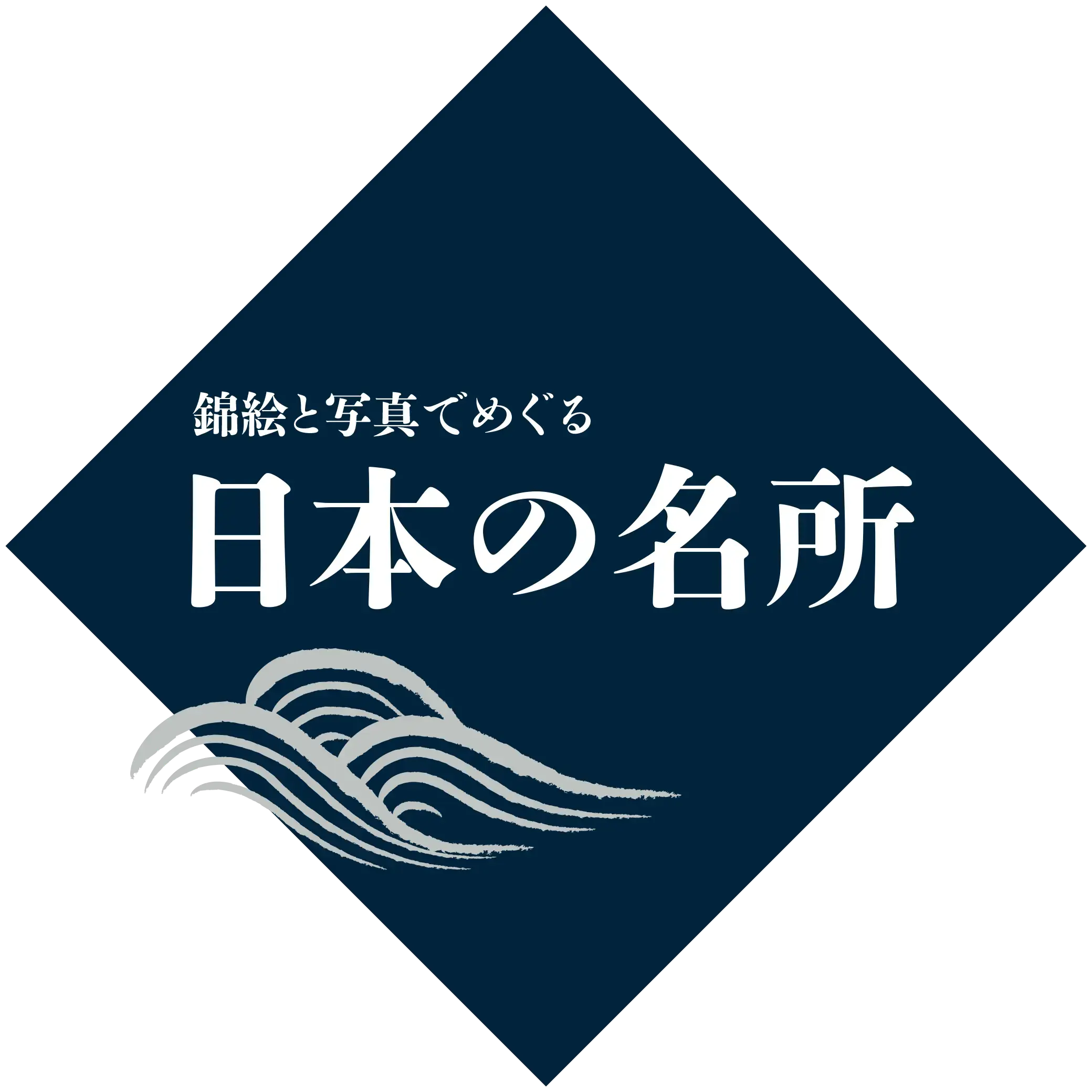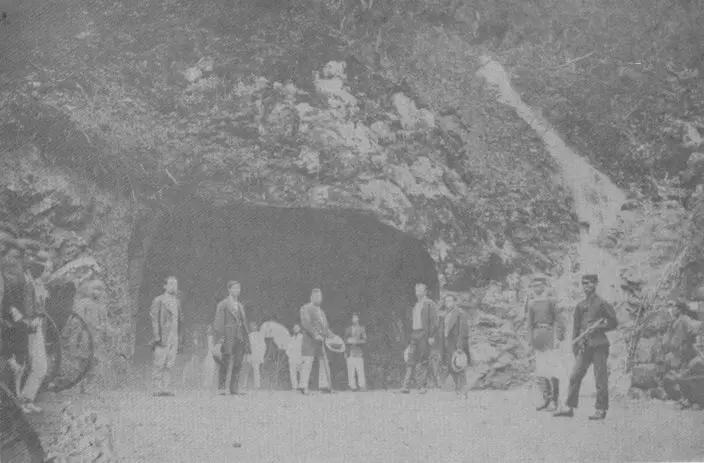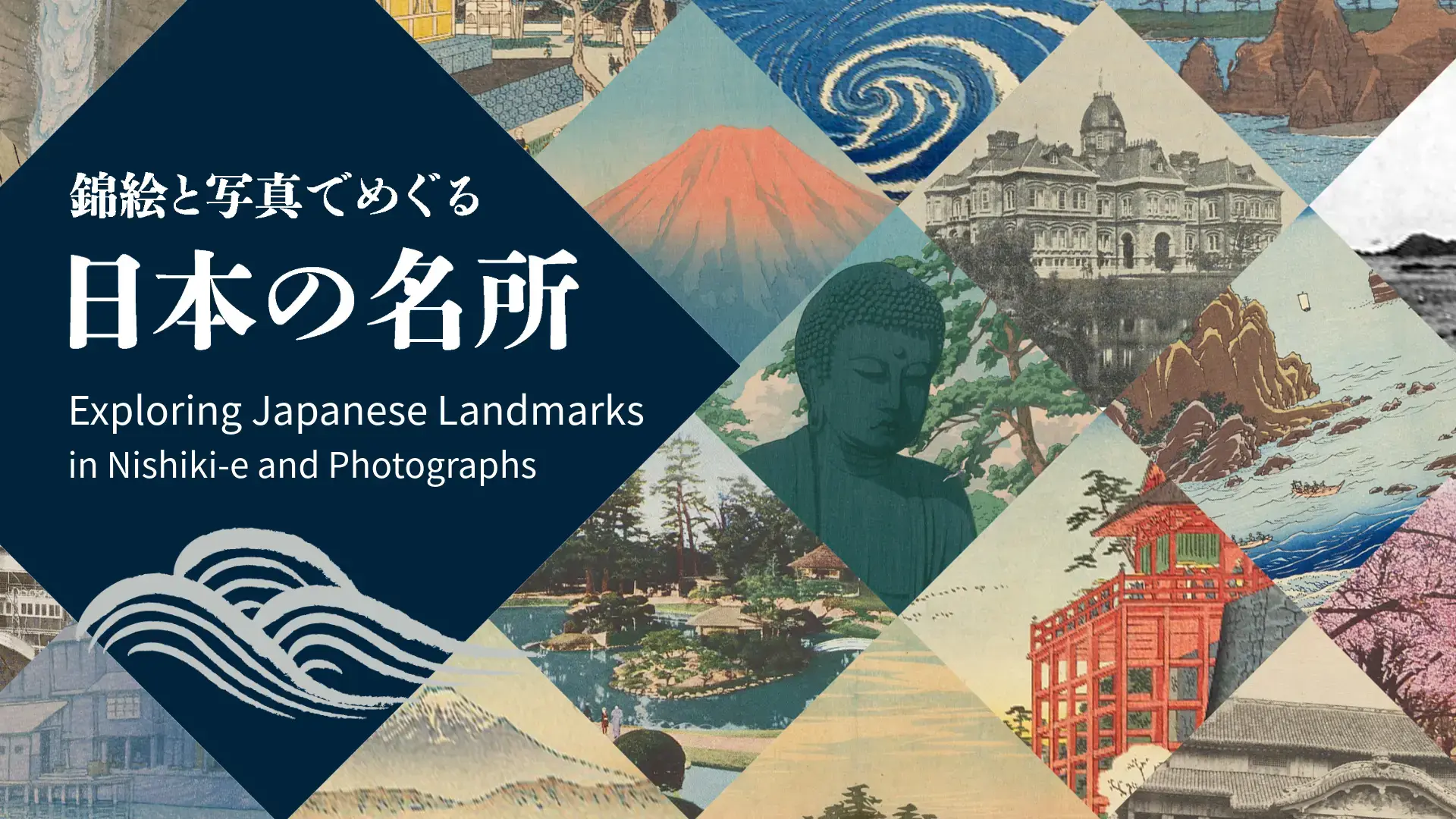
栗子山隧道と三島通庸
このコラムは、平成28年に電子展示会「写真の中の明治・大正(東北編)」の中で公開したコラムを移行したものです。内容は当時の記載内容に基づきます。
雪の栗子山隧道
旅の家つと 第42 奥羽の巻
旅の家つと 第42 奥羽の巻
山形県と福島県を結ぶ交通路の要衝として、かつて栗子山隧道(くりこやまずいどう)というトンネルが使われていた。
写真は明治35(1902)年前後の栗子山隧道の米沢(山形県側)の入り口が雪に埋もれた姿を捉えたものである。豪雪地帯の米沢のこと、かまくらさながらの白銀で幻想的な風景ではあるが、雪の時期は通行が断たれたことを物語る写真だろう。
初代県令のイニシアチブと掘削作業
栗子山隧道とは、明治前期に、山形県(米沢)から福島県(中野村)に至る新道(刈安新道・中野新道)工事の一環として掘られたトンネルである。山形から首都東京を最短でつなぐ、より本格的な交通路を建造するための計画であった。
新道工事のうちでも、栗子山隧道は、標高1,217mの栗子山の山腹に全長約864mのトンネルを掘る未曽有の難工事であり、竣工した明治14(1881)年当時、日本最長のトンネルであった。
トンネル建設の推進者として真っ先に名が挙がるのが置賜・山形・鶴岡を併せた統一山形県の初代県令の三島通庸(みしま みちつね)である。今日「道路県令」「土木県令」の異名で知られる三島は、賦役や費用負担の重さで住民の反発を招きつつ、道路・トンネル・橋・学校などの建設を矢継ぎ早に進めていった。
栗子山の名は頂上が円くて三峰が並ぶ姿を栗になぞらえる古老の言い伝えをもとに採用されたが、一説によるとこの命名にも三島の意向があったといわれる。
馬車を通す
新道の建設にあたっては、馬車を通す道幅を確保することが大前提であった。新道の幅は4間(約7.2m)とされ、トンネルの内空も馬車同士がすれ違えるように設計された。

上の写真は、栗子山隧道の山形(西側)の入り口の前で、工事中に視察する三島やオランダ人技師エッセル(G.A.Escher)をとらえているが、トンネル内をよくよく覗きこむと、馬車が停まっているのが見える。あるいは彼らが乗ってきた馬車だろうか、トンネルの左側にもわずかに馬車の車輪が写り込んでいる。
貫通の日
栗子山隧道の着工は明治11(1878)年1月のことであるが、掘削の大いなる助けとなったのが、前年の年末に米国から届いた最新の穿孔機であった。福島(東側)からは鑿(のみ)や火薬など、手作業で掘り進め、山形(西側)からは機械も用いて掘ったということになる。穿孔機の威力は「坑夫ノ二十余人」と評されるほどで、作業は著しくスピードアップしたという。
貫通は明治13(1880)年10月19日の未明のことであった。山形側からは約470m、福島側からは約404mのところで交わったが、当時の記録によると、開通の瞬間は至ってドラマティックだったようだ。
県令の三島自ら西口の工事小屋に寝泊まりして貫通を待ったが、19日の午前1時頃、トンネルの鑿の音が変わる。「一ノ鏨鋩ノ東西ヨリ相ヒ交ハルヲ見ル、衆皆ナ悦喜、貫ケタ貫ケタト相ヒ呼フノ声一時騒然タリ」と、貫通の判明に一同は高揚した。
記録によると、このとき通じた穴は大きくはなかったものの、トンネルの景色や様子は「俄然トシテ変シ」、風が東より西口に通じ掘削に使っていた火薬の煙気も消え、空気の流れが感じられたという。
ぬけたりと よぶ一声に夢さめて 通ふもうれし 穴の初風
との三島の一首が、今日に高揚を伝えている。
明治天皇の通行
併行して福島県側からも新道の工事が進められ、福島―山形間の新道は完成した。
明治14(1881)年10月3日、東北巡幸中の明治天皇を迎えての開通式は、新道の格好の晴れ舞台となった。巡幸に先立ち、工事中、こぼれ落ちた石の清掃のために荷車48輛を新造して往来させるなど、関係者はトンネルの掃除に励んだ。
開通式当日、明治天皇は山形県から栗子山隧道を通って福島県に向かった。天皇は、トンネルの西側の入り口で輿を降り、山形県令・三島の先導のもと、左右の燈火に助けられながら徒歩でトンネルを渡り、無事福島側に到達して福島県令の出迎えを受けた。
栗子山隧道を含む両県を結ぶ新道に対し、明治天皇はのちに「万世大路」の名を贈り、地元の労に報いている。
この年の巡幸で天皇は秋田、山形、北海道などを巡り、山形県庁(山形)、山形県師範学校や宿泊所ともなった西田川郡役所(鶴岡)など山形県下の数々の建物も、このとき天皇の眼に触れることとなった。
栗子山隧道のその後
しかし、明治32(1899)年に鉄道(現奥羽本線)が開通して鉄路で山形と福島がつながるに至って、栗子山隧道の役割は、急激に低下していった。冬季の通行も遮断されがちで、自動車での通行を見越した昭和の大改修(昭和8(1933)年から12(1937)年)により隧道や万世大路もその姿を変えていくが、昭和41(1966)年完成の栗子ハイウェイにその使命を譲る。昭和47(1972)年の大落盤事故もあり、隧道は通行不能となった。
しかし、新道や隧道の竣工前後の姿は、三島の命で黎明期の写真技術を支えた写真師・菊地新学によって記録され、各地の隧道や新道は近代日本を代表する洋画家である高橋由一の画題ともなった。建設前後の姿は写真や絵画に鮮やかにとどめられ、三島通庸が推進した土木事業の代表として、歴史にその名を残している。
引用・参考文献
- 「抗甲山名称ノ件」明治11年1月19日「三島通庸関係文書」482-13(国立国会図書館憲政資料室所蔵)
- 「栗子新道工事始末記」明治15年「三島通庸関係文書」482-17(国立国会図書館憲政資料室所蔵)
- 宮内庁編『明治天皇紀.第5』吉川弘文館,1971 【288.41-M448K4m】
- 高橋由一[画],那須塩原市那須野が原博物館編『近代を写実せよ』那須塩原市那須野が原博物館,2014 【GK184-L220】
- 西那須野町,尾埼尚文編『高橋由一と三島通庸』西那須野町,1981 【KC16-1030】
- 万世大路研究会監修『万世大路を歩く:万世大路調査研究実行委員会』2010 【DK32-J65】
- 『山形県史.第4巻(近現代編 上)』山形県,1984 【GC31-55】
- 山形県史編さん委員編『山形県史.資料篇 第2 (明治初期 下 三島文書)』巌南堂書店,1962 【GC31-8】
- 「菊地新学 山形写真帖」(山形県立図書館ホームページ)








